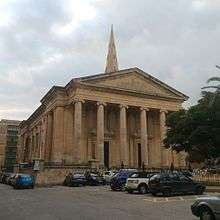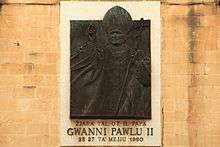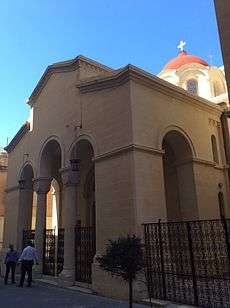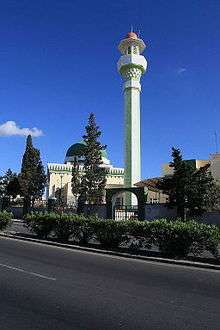Religion in Malta
The predominant religion in Malta is that of the Catholic Church. The Constitution of Malta establishes Catholicism as the state religion, and it is also reflected in various elements of Maltese culture; however, in recent years the church has experienced rapid decline in influence and importance. According to a 2018 survey, the overwhelming majority of the Maltese population adheres to Christianity (95.2%) with Catholicism as the main denomination (93.9%). According to the same report, 4.5% of the population declared themselves as either atheist or agnostic, one of the lowest figures in Europe.[1]
.jpg)


Malta's patron saints are St Paul, St Publius and St Agatha. The Assumption of Mary known as Santa Marija is the Special patron of the Maltese Islands.
History of religion in Malta
Religion and the law
Constitutional standing
Article 2 of the Constitution of Malta states that the religion of Malta is the "Roman Catholic apostolic religion" (paragraph 1), that the authorities of the Catholic Church have the duty and the right to teach which principles are right and wrong (paragraph 2) and that religious teaching of the Catholic apostolic faith shall be provided in all state schools as part of compulsory education (paragraph 3).
Malta, a signatory to the Protocol 1 to the European Convention on Human Rights, made a declaration saying that it accepts the protocol's article 2 (on parents' right to have their children educated in line with their religious or philosophical views) only insofar "as it is compatible with the provision of efficient instruction and training, and the avoidance of unreasonable public expenditure, having regard to the fact that the population of Malta is overwhelmingly Roman Catholic".[2]
However, article 2(1) and (3) of the Constitution are not entrenched, unlike article 40 which guarantees full freedom of conscience and of religious worship and bars the requirement of religious instruction or to show proficiency in religion. This means that if the provisions of article 2(1) and (2) are in conflict with the rights guaranteed under article 40, the provisions of the latter prevail. With regards to religious instruction in public schools for example, students may opt to decline participation in Catholic religious lessons.
Malta officially supported Italy and was one of ten states presenting written observations when the case Lautsi v. Italy was to be heard by the Grand Chamber of the European Court of Human Rights over the exhibiting of the crucifix in classrooms.
Religion and public policy
Malta was the last European country (excluding the Vatican City) to introduce divorce in October 2011 after voting in a referendum on the subject earlier in the year.[3] Furthermore, Malta has also repealed vilification of religion as a crime in July 2016.[4]
Abortion in Malta is illegal in all circumstances.[5][6] Over the years some loopholes (non-inclusion of outer territorial waters, no mention of advertising) permitted individuals to circumvent the ban for limited time periods.[7]
Religious belief and participation
According to a Eurobarometer Poll held in 2005, 95% of Maltese responded that they "believe there is a God", 3% responded that they "believe there is some sort of spirit or life force" and 1% responded that they "don't believe there is any sort of spirit, God or life force" which was the lowest percentage of non-believers in all countries surveyed together with Turkey, Romania and Poland. 1% gave no response.[8]
In a report published in 2006, it was reported that 52.6% of Maltese (older than 7 years and excluding those not able to attend) attended Sunday mass in 2005, down from 75.1% in 1982 and 63.4% in 1995. Hence, Sunday mass attendance has dropped annually by 1% since 1982.[9] According to Archbishop Charles Scicluna, Sunday mass attendance dropped further to roughly 40% by 2015.[10] The 2017 census revealed that 36.1% of the catholic population attended mass on the census day, which was over the course of a weekend in December 2017, a drastic decline compared to previous years.[11]
Church weddings have also declined since 2010, with a rapid increase in civil weddings. In 2010 a total of 1,547 church weddings and 740 civil weddings were registered . However in 2018, church weddings declined to 1,129 while civil weddings increased to 1,423.[12]
The number of students who opt out of studying religions knowledge in schools has also increased. In 2014 an ethics class was created for those who choose not to attend school religion lessons, which as yet are still part of the curriculum. In 2014, there was a total of 1,411 students who opted out of religions lessons while in 2019 the number increased to 3,422, an increase of 142%.[13]
According to a survey carried out in 2018, around 63.7% of the Maltese population considered themselves as practicing members of their religion.[1]
| Year | % of weekly church attendance in Malta among Catholics | |
|---|---|---|
| 1967 | 81.9 | |
| 1982 | 75.1 | |
| 1995 | 63.4 | |
| 2005 | 52.6 | |
| 2017 | 36.1 | |
Vernacular cult and beliefs
- Karmni Grima, Our Lady of Ta' Pinu, Frenċ tal-Għarb
Religious organizations
- Zghazagh Azzjoni Kattolika: Catholic children and youth organization, member of Fimcap
Pastoral visits

Pope John Paul II made three pastoral visits to Malta: twice in 1990 and once in 2001. In his last visit he beatified three Maltese people: George Preca (who was then canonised in 2007), Nazju Falzon and Adeodata Pisani.
In April 2010, Pope Benedict XVI also visited Malta in the celebration of the anniversary of 1950 years of the shipwreck of Paul in Malta.[14]
Catholic churches in Malta
In the small island state of Malta, the church or chapel is a common feature of the landscape. Many churches in Malta dominate the skyline, and the domes and steeples can usually be seen from across the island. One can usually find the centre of a town or village by driving towards the parish church, although many towns and village cores feature two or more churches and chapels.
On the islands of Malta and Gozo, which are two separate dioceses, there are a total of 359 churches (313 in Malta and 46 in Gozo). Of these, 78 are parishes (63 in Malta and 15 in Gozo) and six are national parishes.[15] This means that there is a "church density" of slightly more than one church per square kilometer. In Malta, every locality has its parish church, apart from two or three small localities. There are also localities that have more than one parish church, like Sliema and Birkirkara, which have four parishes each.
Other Christian denominations in Malta
Protestant Churches
The Anglican church in Malta has two parish churches, St Paul's and Trinity, and one chaplaincy which covers all of Gozo. The parishes are part of the Diocese in Europe of the Church of England. There are around 300 active Anglicans in Malta however the inactive Anglican population is significantly higher.
There is also a Presbyterian congregation which united with the Methodist congregation in 1975 and today worship as one congregation in St Andrew's. The Presbyterian congregation is part of the International Presbytery of the Church of Scotland.
A Lutheran congregation, mostly made up of Germans and Scandinavians, worship in St Andrew's Church as well though as a separate congregation.
The Bible Baptist Church caters to the Baptists congregation in Malta. The Evangelical Alliance of Malta (TEAMalta)[16] has seven churches and two organisations that are affiliated, with about 400 members between them.
Orthodox Churches
The Orthodox presence in Malta is also numerous, with a substantial increase in the past years. In 2014 there were at least 5000 orthodox believers or 1.2% of the total population. The Russian Orthodox Church in Malta has its own parish of St Paul however they do not have a permanent church and hence use the Greek Catholic church of Our Lady of Damascus in Valletta for services. The Bulgarian Orthodox and Armenian Orthodox congregations also use the same church for services. There is a Greek Orthodox congregation which has its own church of St George, part of the Greek Orthodox Archdiocese of Italy and Malta. The Romanian Orthodox Church congregation worships in St Roque's Church and is part of the Romanian Orthodox Diocese of Italy. There is also a strong Serbian Orthodox congregation in Malta, which uses St Nicholas' for worship. The Serbian parish is part of the Serbian Orthodox Eparchy of Austria and Switzerland. The Coptic Orthodox Church congregation forms part of the Patriarchate of Alexandria and worships in St James' Chapel in Żebbuġ. There are also congregations belonging to the Ethiopian Orthodox Tewahedo Church and the Eritrean Orthodox Tewahedo Church respectively, both of which use the Church of St James, Valletta.
Others
In 2008, the seven congregations of Jehovah's Witnesses reported 569 active adherents, with an annual Memorial attendance of 1120. The Church of Jesus Christ of Latter-day Saints (Mormons) also has a congregation in Malta.
Non-Christian Religions in Malta
There are also a number of non-christian religions. There is one Jewish congregation. There are various Hindu families in Malta that practice their own Hindu faith however there are no Hindu temples and the Hindu deceased are buried in Malta instead of being cremated.
There is one Muslim mosque and a Muslim faith school. Of the estimated 3,000 Muslims in Malta, approximately 2,250 are foreigners, approximately 600 are naturalized citizens, and approximately 150 are native-born Maltese. [17] The Ahmadiyya Muslim Community is also present.
Zen Buddhism and the Bahá'í Faith also have about 40 members.
Paganism is also alive in Malta, with a small yet strong community counting at least 100 individuals who identify as such.
See also
- Christianity in Europe
- Culture of Malta
- Freemasonry in Malta
- History of Malta
- List of Churches in Malta
- Religion by country
- Religion in Europe
- Religion in the European Union
References
- "MaltaToday Survey | Maltese identity still very much rooted in Catholicism". MaltaToday.com.mt. Archived from the original on 26 March 2019. Retrieved 26 March 2019.
- http://conventions.coe.int/Treaty/Commun/ListeDeclarations.asp?PO=MAL&NT=009&MA=999&CV=1&NA=&CN=999&VL=1&CM=5&CL=ENG
- "MPs in Catholic Malta pass historic law on divorce". BBC News. 25 July 2011.
- http://www.timesofmalta.com/articles/view/20160712/local/bill-decriminalising-vilification-of-religion-approved-a-sad-day-for.618649
- "Europe's abortion rules". BBC News. 12 February 2007.
- "Malta Government Responds to EU's Pro-Abortion Recommendation". Euthanasia.com. 23 July 2002. Retrieved 6 November 2011.
- Steven Ertelt (17 July 2006). "Malta pro-life advocates can't stop Spain abortion business from running ads". Life News.com. Retrieved 18 June 2006.
- Special Eurobarometer Social values, Science and Technology, Secial Eurobarometer 225 / Wave 63.1 – TNS Opinion & Social (PDF), European Commission, June 2005, p. 9, archived from the original (PDF) on 6 April 2007
- "Preliminary Report" (PDF). Retrieved 6 November 2011.
- "Percentage of Maltese who attend Church has dropped to about 40% - Mgr Charles Scicluna". The Malta Independent. 24 March 2015. Retrieved 24 March 2015.
- "Census finds increasingly aging church-going population; only 36.1% of Catholics attend Mass". Malta Today. 31 January 2019.
- "Number of marriage separations outnumber Church weddings in 2018". Times of Malta. 28 January 2019.
- "More students opt out of religion classes in school, 142% increase since 2014". Times of Malta. 6 February 2019.
- Alessandra Stanley (9 May 2001). "Valletta Journal: Malta greets the Pope like a beloved spa client". New York Times. Retrieved 18 June 2006.
- Charles Buttigieg, P.R.O., Archbishop's Curia, Malta (24 October 1995). "THE CATHOLIC CHURCH IN CONTEMPORARY MALTA". Retrieved 15 November 2007.CS1 maint: multiple names: authors list (link)
- http://teamalta.org
- "International Religious Freedom Report 2003 – Malta". Bureau of Democracy, Human Rights, and Labor, United States Department of State. Retrieved 9 January 2008.
External links
| Wikimedia Commons has media related to Religion in Malta. |


